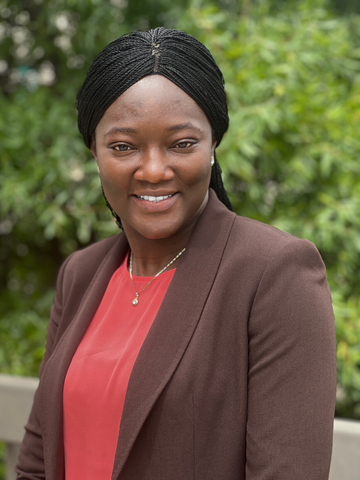Media contact: Anna Jones
 Ellen Antwi-Adjei, OD, MPHThree students from the Vision Science Graduate Program at the University of Alabama at Birmingham School of Optometry have been awarded Ezell Fellowships from the American Academy of Optometry Foundation. This is the largest number of VSGP winners in a single year.
Ellen Antwi-Adjei, OD, MPHThree students from the Vision Science Graduate Program at the University of Alabama at Birmingham School of Optometry have been awarded Ezell Fellowships from the American Academy of Optometry Foundation. This is the largest number of VSGP winners in a single year.
The recipients and their fellowships are:
- Ellen Antwi-Adjei, O.D.: Michael G. Harris Ezell Fellow
- Mahmoud KhalafAllah, M.D.: Rod Tahran/Essilor Ezell Fellow
- Yvonne Adu-Agyeiwaah, O.D.: American Academy of Optometry Ezell Fellow
The Ezell Fellowship program is extremely competitive. Named after the founding president of the AAOF, William C. Ezell, O.D., it was established to provide recognition and support to talented postdoctoral students pursuing an advanced optometric research and education degree. Over 430 William C. Ezell Fellowships have been awarded since the program’s inception in 1949. The program has produced hundreds of investigators who have become leaders in optometric education and contributed greatly to the body of research in vision science and optometry.
“The winners this year are all international students who have already demonstrated great potential in their former educational backgrounds,” said Lawrence Sincich, VSGP director. “They are very ambitious and have real interests in learning how to be good educators in their own right, which is one of the hallmarks expected for Ezell Fellows. What is also important is that the specific projects our awardees are working on are very close to the heart of the interests that define optometric research.”
 Mahmoud KhalafAllah, MD, MScAntwi-Adjei, from Ghana, is researching telemedicine to detect ocular diseases. Her efforts could yield greater access to eye care for people in underserved areas, bridging the gap between urban and rural eye health.
Mahmoud KhalafAllah, MD, MScAntwi-Adjei, from Ghana, is researching telemedicine to detect ocular diseases. Her efforts could yield greater access to eye care for people in underserved areas, bridging the gap between urban and rural eye health.
“Quality of life and the ability to perform daily living activities are directly related to visual function,” Antwi-Adjei said. “I am interested in assessing the efficacy and practicality of portable visual field devices to screen for glaucoma and other ocular diseases in the context of telemedicine.”
To further her research, Antwi-Adjei is involved in a clinical trial, known as AL-SIGHT, funded by the Centers for Disease Control and Prevention. The trial uses telemedicine for the early detection of glaucoma and other ocular conditions in rural areas of the state.
KhalafAllah, from Egypt, is studying the impact of early-onset myopia on the optic nerve head and the increased risk for glaucoma development later in life. His research findings can contribute to innovative diagnostic and therapeutic approaches for these conditions.
“These conditions have a profound impact on individuals worldwide, and I felt compelled to contribute to the understanding and treatment of these sight-threatening disorders,” KhalafAllah said. “Ultimately, my goal is to bridge the gap between research and clinical practice, positively influencing the lives of patients worldwide affected by these conditions.”
KhalafAllah’s work builds on his graduate research career at UAB when he conducted in-depth investigations into the developmental mechanisms and optic nerve head remodeling in myopia and glaucoma. His career goal is to become a physician-scientist specializing in glaucoma.
 Yvonne Adu-Agyeiwaah, O.D.Adu-Agyeiwaah, from Ghana, is researching diabetic retinopathy. She is particularly interested in mechanisms for regulating retinal and systemic cholesterol levels to prevent the progression of diabetic retinopathy and to potentially reverse the condition.
Yvonne Adu-Agyeiwaah, O.D.Adu-Agyeiwaah, from Ghana, is researching diabetic retinopathy. She is particularly interested in mechanisms for regulating retinal and systemic cholesterol levels to prevent the progression of diabetic retinopathy and to potentially reverse the condition.
“My research is investigating the use of alpha-cyclodextrin in reversing diabetic retinopathy,” Adu-Agyeiwaah said. “Alpha-cyclodextrin can dissolve cholesterol crystals. We have found that there are cholesterol crystals present in the retinas of people with diabetes. From the findings we have so far, we believe the crystals contribute to diabetic retinopathy in patients.”
Her interest in studying diabetic retinopathy was piqued during Adu-Agyeiwaah’s clinical practice as an optometrist.
“I realized that the standard treatment for diabetic retinopathy patients was intravitreal anti-VEGF administration,” Adu-Agyeiwaah said. “There was, however, a large number of patients who did not benefit from this treatment. I got curious to know more detail about the elemental factors contributing to the disease, and I was happy to end up researching just that for my Ph.D.”
The UABSO faculty includes four Ezell Fellows: Jillian Ziemanski, O.D., Ph.D., Timothy W. Kraft, Ph.D., Jason J. Nichols, O.D., Ph.D., and Kelly K. Nichols, O.D., Ph.D.